For the last month we’ve had a trio of mallards staying with us. Mallards are nothing unusual anywhere in North America but we haven’t attracted many here in our wetland over the past several years.
The current trio, two drakes and a duck, have been foraging heavily. One day I noticed them intently digging and mucky around in the swamp across from the Main Wetlands Overlook, between the overlook and the Black Bear Compound.
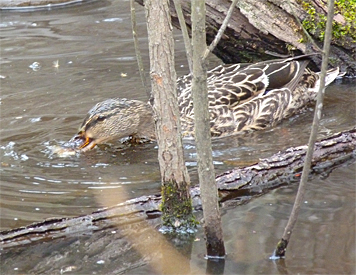
The mallards were probing the mud and leaves in the shallow water apparently attempting to dislodge something from the muck. I saw the female trying desperatley to either eject something from her bill or swallow it, I wasn’t quite sure which. She finally swallowed the object. I thought it was a leaf that was giving the duck so much trouble but as I reviewed the photos later on a computer I realized it was a tadpole.

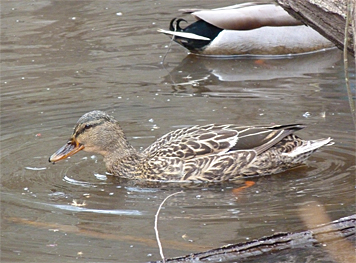
The mallards were apparently seeking out the tadpoles.
A Northern Flicker
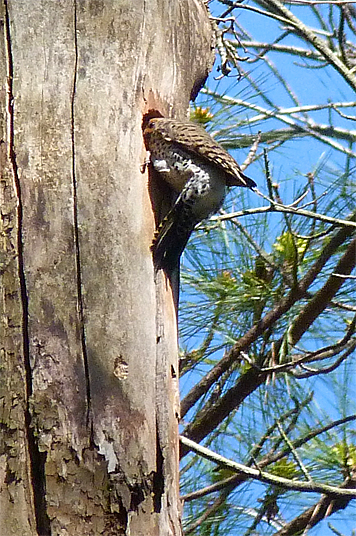
There has been a change in the Wetland’s kingfisher dynamics. In previous years a male would arrive on the scene sometime in March. The male would flash around the Wetlands for a day or two trying to impress the female, snatch up a fish, bring his prize over to her and hope for the best. Not long after the male’s arrival the female would disappear for most of the month of April, if not longer, presumably performing nest duty. I would occasionally see the male during the time that the female was off incubating and caring for the young in the nest, the female even less frequently.
Then sometime in May the female and male would return to the Wetlands with two or three young kingfishers in tow, fishing lessons followed. After satisfying themselves that the youngsters could manage on their own, or after having had enough of the youngster’s squabbling and begging (a few days), they would ask them to leave the area, to go off and find their own fishing holes. The male would disappear at this time also, leaving the Wetlands to our female.
A male has indeed arrived. As usual, he came in sometime during the month of March. He now frequents the Wetlands whereas previously he, or whoever the male was from previous years, would be off to some other fish pond leaving the Wetlands behind while the female incubated the eggs.
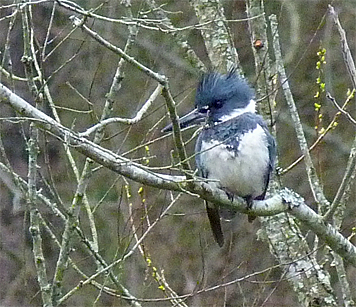

I have not seen our resident female for some time. She is easily recognizable due to the markings on her lower breast. Female kingfishers have a band of chestnut colored feathers across their lower breast or upper belly in addition to the blue band on the upper breast. This brown band varies from female to female from a thick heavy band to simple brown spots on the sides of the breast. Our female had an incomplete band of feathers across her breast. The female that I now see in our Wetlands has a complete breast band, it’s a different female.
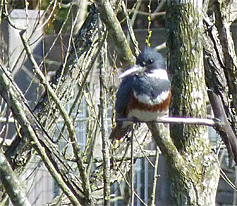
Exactly when the change took place I can’t say, but I don’t recall seeing our local bird for at least a month.
It’s not exactly clear to me what has occured, whether our resident female was pressured to leave or has been absent due to nesting duties and the other female kingfisher is taking advantage of her absence to claim the Wetlands as her own.
I know that some species of kingfisher have help raising their young by the use of “helpers.” The helpers may consist of the previous year’s young come back to lend a hand, or wing, to the effort of raising young by swapping incubating duty or actively fishing once the eggs hatch. I haven’t been able to find anything in the literature which indicates that behavior in the Belted Kingfisher so perhaps we have a new resident female. As I said, I’m not entirely sure what’s happening and it’s possible that the new female was simply a bird that was moving through the area on her way somewhere else. I’m anxious to see if our resident female with the reduced breast band shows up in May with fledglings.
Northern Rough-winged Swallows
A Northern Rough-winged Swallow stopped in briefly on Tuesday (4/2), taking a few turns around the Wetlands and perching on a birch out in front of the Main Wetlands Overloook. The following day, a wet, cold and miserable day, I saw two or three of these long winged swallows working the Wetlands. I wondered how they could find any flying insects (their preferred food) on such a day. Hawking insects is, though, how they make a living, so I assume they knew what they were doing. I had seen another rough-winged a week before, but it blew through with the wind and did not stop to feed.
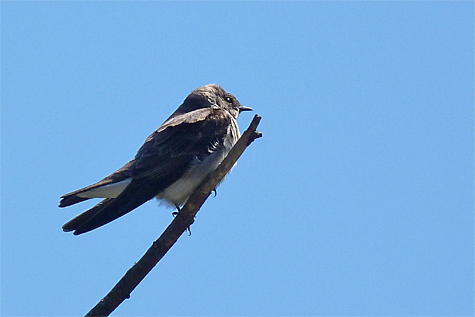
A Warbler plus
A Yellow-throated Warbler surprised me as I was walking down the path above the Lemur House. The temps were in the 70s and there were southwest winds the night before. Migrants were in the trees. The warbler was picking off insects in a pine tree close to the path, at eye level, no more than ten feet from me. A beautiful bird, for sure.

I also saw the first of the year Blue-gray Gnatcatcher and heard a Hermit Thrush break into song, a good day.
A few herps
In the herpetological world, the first of the year water snakes were basking on the north side of the Wetlands on Tuesday. Two Northern Water Snakes were soaking up the sun on the very pleasant second day of April.
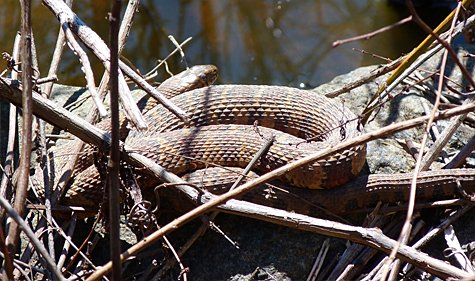
Big Red is among us! We have two large female Northern Water Snakes in our Wetlands that are individually recognizable. Both have reddish bands and as I said, are rather large. One has a stump for a tail, it having been shortened, I assume, by a snapping turtle. That’s Stumpy. The other snake is Big Red, and she was out basking in a willow on Friday (4/5).
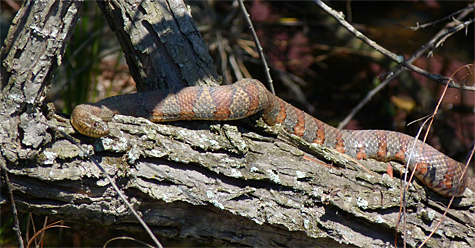
On Monday (4/1), while here on an off duty jaunt through Catch the Wind I heard and saw an American Toad calling for a mate from the pond at Flap The Wings. As with many natural events this spring the toads are late, they’re usually calling by mid-March.
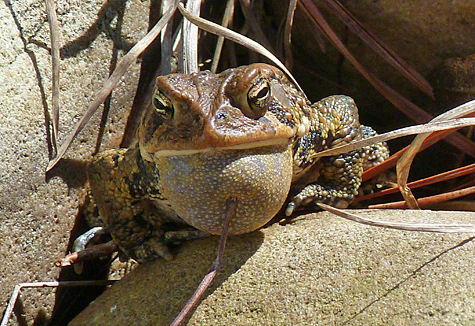
The sun is now shinning again and the 5-day is calling for 70s and 80s, get out and enjoy while it lasts.
Kingfishers are such awesome birds! Great story Greg.
Do you think birds have much of a sense of taste?
No, in fact taste and smell are the two least developed senses in most birds. Sweet, sour, bitter, and salty tastes are what most birds can distinguish. An example of underdeveloped (by our standards) taste and smell senses might be that Great Horned Owls are about the only creature that I know of that will eat a skunk. Certainly, besides the ferocity involved, they must not be able to smell the skunk. And, anything that smells so bad surely must not taste very good after being sprayed. Most birds rely more heavily on sight and sound to find food. They have far fewer taste buds than we humans, maybe 500 as compared to about ten thousand which frees them up to eat many things that we would find very distasteful.